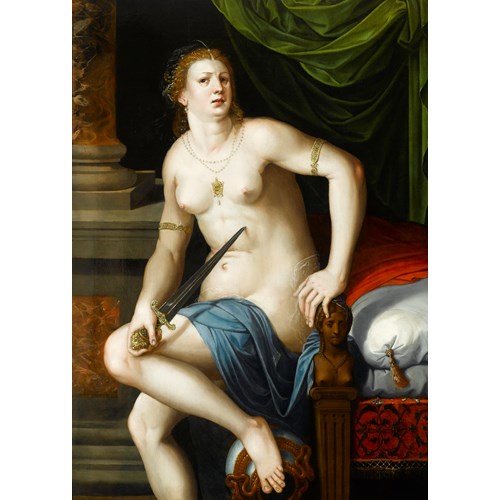Marketplace
Tatar Troops Swearing Allegiance to the Tsar Before the Regiment Banner
Otto Gerlach
Tatar Troops Swearing Allegiance to the Tsar Before the Regiment Banner
Period 1850-1900, 19th century
Origin Germany
Medium Watercolour, Gouache on paper
Dimension 31 x 46.5 cm (12¹/₄ x 18¹/₄ inches)
This historically intriguing watercolour shows Tatar troops swearing allegiance to Imperial Russia. In the foreground a bearded man wearing a turban, possibly a mullah or local elder, reads from a sheet of paper to a group of soldiers gathered around him. To his left is a table covered in a white cloth upon which several scrolls are placed. Some of the surrounding soldiers have raised their right arm in salute, whilst others listen intently. All of the soldiers wear identical caps emblazoned with white cockades, presumably identifying them to their local regiment. As well as heavy collared coats and belts, they hold rifles with bayonets attached. In the centre, a Tatar soldier facing the viewer clutches the regimental banner in his left hand. The ceremony is framed by a large classical building with a cupola, and bare trees stripped of their leaves, suggesting that this scene is taking place in winter. The subtle use by Otto Gerlach of white heightening on the trees, as well as on the faces and collars of the soldiers, further adds ro the sensation of the cold climate.
The Tatars are a predominantly Muslim, Turkic-speaking ethnic group that inhabit Russia, Uzbekistan, Kazakhstan, Ukraine, Kyrgyzstan, Bulgaria, Romania, Lithuania, and Poland. In 922, the Tatars’ predecessors, the Bulgars, converted to Islam, and the old Turkic script was replaced by the Arabic alphabet. Historically, the rise of the Tatar groups throughout Central Asia occurred as Mongol control in the area weakened during the mid-fifteenth century, enabling several successor states to emerge. During the fifteenth and early sixteenth centuries, the Kazan Khanate (local Tatar feudal state) became the most prominent of these states, and its people became known as the Tatars. The Kazan Tatars were conquered by Imperial Russian forces in 1552, during the reign of Tsar Ivan IV (1530-1584), thus becoming the first Muslim subjects of the Russian Empire.
Although we cannot be certain of the location of the present work, it is most probable that the soldiers originate from one of the numerous Tatar groups found throughout Central Asia and the Caucasus. Though culturally independent, many Tatar groups were absorbed into the Russian state in the nineteenth century after the Empire annexed Central Asian and Caucasian land from the Persian Qajar dynasty during the Russo-Persian Wars of 1804-1813 and 1826-1828. Furthermore, Russian territorial conquests in the eighteenth and nineteenth centuries in the North Caucasus brought the Muslim peoples of this region - Dagestanis, Chechens, Ingush, and others - under Russian control. Further afield, the independent states of Central Asia and Azerbaijan were also occupied as part of the same imperialist push that incorporated the North Caucasus. Though Islam was repressed by the Russian state, many Tatars enrolled into the Russian army during the nineteenth century to become officers and soldiers, and the present work clearly represents such a conscription ceremony. Other Tatars converted to Russian Orthodoxy and became Cossacks defending Russia’s borders.
The present watercolour is a particularly fine example of Gerlach’s work. This widely travelled artist specialised in military scenes, and the clarity of composition and narrative seen here, demonstrates the esteemed style which led to his work being often reproduced in illustrative periodicals.
The Tatars are a predominantly Muslim, Turkic-speaking ethnic group that inhabit Russia, Uzbekistan, Kazakhstan, Ukraine, Kyrgyzstan, Bulgaria, Romania, Lithuania, and Poland. In 922, the Tatars’ predecessors, the Bulgars, converted to Islam, and the old Turkic script was replaced by the Arabic alphabet. Historically, the rise of the Tatar groups throughout Central Asia occurred as Mongol control in the area weakened during the mid-fifteenth century, enabling several successor states to emerge. During the fifteenth and early sixteenth centuries, the Kazan Khanate (local Tatar feudal state) became the most prominent of these states, and its people became known as the Tatars. The Kazan Tatars were conquered by Imperial Russian forces in 1552, during the reign of Tsar Ivan IV (1530-1584), thus becoming the first Muslim subjects of the Russian Empire.
Although we cannot be certain of the location of the present work, it is most probable that the soldiers originate from one of the numerous Tatar groups found throughout Central Asia and the Caucasus. Though culturally independent, many Tatar groups were absorbed into the Russian state in the nineteenth century after the Empire annexed Central Asian and Caucasian land from the Persian Qajar dynasty during the Russo-Persian Wars of 1804-1813 and 1826-1828. Furthermore, Russian territorial conquests in the eighteenth and nineteenth centuries in the North Caucasus brought the Muslim peoples of this region - Dagestanis, Chechens, Ingush, and others - under Russian control. Further afield, the independent states of Central Asia and Azerbaijan were also occupied as part of the same imperialist push that incorporated the North Caucasus. Though Islam was repressed by the Russian state, many Tatars enrolled into the Russian army during the nineteenth century to become officers and soldiers, and the present work clearly represents such a conscription ceremony. Other Tatars converted to Russian Orthodoxy and became Cossacks defending Russia’s borders.
The present watercolour is a particularly fine example of Gerlach’s work. This widely travelled artist specialised in military scenes, and the clarity of composition and narrative seen here, demonstrates the esteemed style which led to his work being often reproduced in illustrative periodicals.
Period: 1850-1900, 19th century
Origin: Germany
Medium: Watercolour, Gouache on paper
Signature: Signed ‘O. Gerlach’ (lower left).
Dimension: 31 x 46.5 cm (12¹/₄ x 18¹/₄ inches)
More artworks from the Gallery









